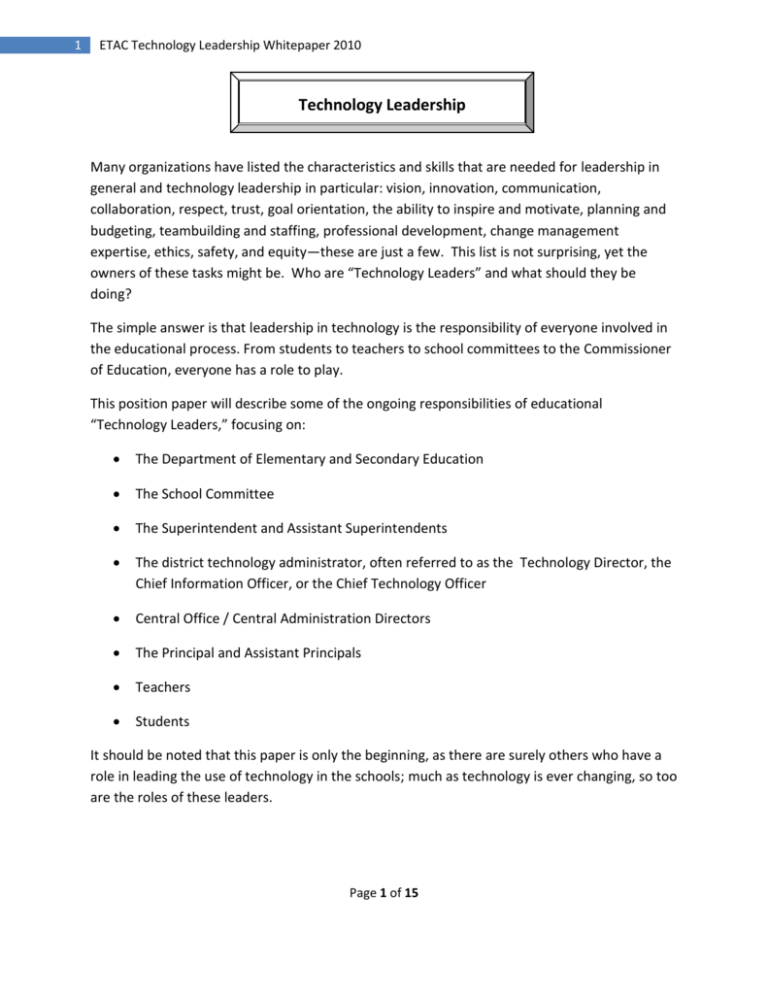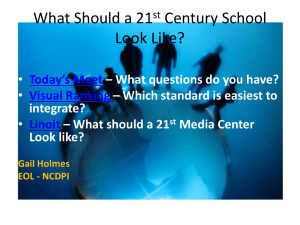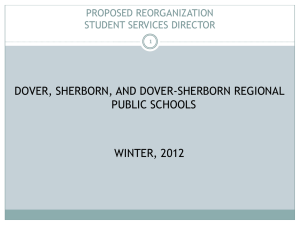Technology Leadership Whitepaper 2010
advertisement

1 ETAC Technology Leadership Whitepaper 2010 Technology Leadership Many organizations have listed the characteristics and skills that are needed for leadership in general and technology leadership in particular: vision, innovation, communication, collaboration, respect, trust, goal orientation, the ability to inspire and motivate, planning and budgeting, teambuilding and staffing, professional development, change management expertise, ethics, safety, and equity—these are just a few. This list is not surprising, yet the owners of these tasks might be. Who are “Technology Leaders” and what should they be doing? The simple answer is that leadership in technology is the responsibility of everyone involved in the educational process. From students to teachers to school committees to the Commissioner of Education, everyone has a role to play. This position paper will describe some of the ongoing responsibilities of educational “Technology Leaders,” focusing on: The Department of Elementary and Secondary Education The School Committee The Superintendent and Assistant Superintendents The district technology administrator, often referred to as the Technology Director, the Chief Information Officer, or the Chief Technology Officer Central Office / Central Administration Directors The Principal and Assistant Principals Teachers Students It should be noted that this paper is only the beginning, as there are surely others who have a role in leading the use of technology in the schools; much as technology is ever changing, so too are the roles of these leaders. Page 1 of 15 2 ETAC Technology Leadership Whitepaper 2010 Additional information regarding national standards can be found at: CoSN Framework of Essential Skills of the K-12 CTO: http://www.cosn.org/EssentialSkillsoftheK12CTO/tabid/4489/Default.aspx ISTE National Educational Technology Standards: http://www.iste.org/AM/Template.cfm?Section=NETS Page 2 of 15 3 ETAC Technology Leadership Whitepaper 2010 The Department of Elementary and Secondary Education The staff of the Department of Elementary and Secondary Education (ESE) provides leadership and vision for the state. Districts depend on them to lead the use of technology in many ways, including but not limited to researching and disseminating best practices, prioritizing federal and state technology grant spending, creating and promoting technology standards for students and staff, and encouraging and strengthening the use of technology in all instructional and administrative areas. Technology leadership is the responsibility of not just the technology staff, but also of the Commissioner of Education, the curriculum leaders in all subject areas, the researchers, the program managers, and all others who influence and work in education. Through innovative and determined initiatives, strengthened by strategic collaborations and partnerships and guided by their existing goals, the ESE will enhance and sustain its position as the technology leader for the elementary and secondary educational community in Massachusetts. The Commissioner of Elementary and Secondary Education’s webpage states that: “We are guided by this mission… "To improve the quality of the public education system so that students are adequately prepared for higher education, rewarding employment, continued education, and responsible citizenship. We carry out our mission in partnership with Massachusetts school districts and other organizations that provide educational programs and services. Students, parents, teachers and other educators, elected officials, business and community leaders, and the public all are stakeholders in the work of the Department to improve schools and raise student achievement." And by these goals… 1. Qualified educators for every public school and classroom 2. High standards for what all students should know and be able to do in the core subjects 3. Adequate resources and support services, used well by schools, districts, and communities 4. Valid, reliable assessment and accountability systems for students, educators, schools, and districts 5. Timely, useful information to stakeholders, and 6. Efficient agency management.” Building upon these goals to provide technology leadership for the Commonwealth, the Commissioner, the Office of Instructional Technology, and all ESE professional staff must ensure the following: Page 3 of 15 4 ETAC Technology Leadership Whitepaper 2010 1. All schools and classrooms have teachers who are highly qualified to teach students how to use technology to adequately prepare them for higher education, rewarding employment, continued education, and responsible citizenship, as well as educational administrators who are qualified to both lead and support them. The ESE must guide the delivery of professional development, both online and face-to-face, in the use of technology for all educators, including administrators and teachers. Standards that delineate what administrators and teachers should know and be able to do with regard to technology must also be overseen by the ESE. 2. The Commonwealth has rigorous and relevant 21st century standards for what all students should know and be able to do in order to use technology for learning. As stated in the current Massachusetts Technology Literacy Standards and Expectations, these standards must “help students develop technology literacy skills to learn the content of the curriculum, as well as to be able to succeed and thrive in their adult lives. These skills will help them function effectively in a world where new technologies continue to emerge and information grows ever more abundant.” In support of lifetime and anytime, anywhere learning, the use of online coursework and resources must also be championed by the ESE. 3. All schools, districts, and communities know the meaning of “adequate technology resources and support services,” understand the importance of procuring these assets and keeping them current, and, as new technologies continue to emerge, stay knowledgeable on how to use them strategically and proficiently. Particularly in difficult economic times, the ESE also needs to provide leadership to districts on how to fund these ongoing purchases, including hardware, software, and networking. 4. All schools have valid, reliable assessment systems for measuring technology skills and knowledge, including those 21st century skills that may be difficult to assess. Technology should also be utilized to provide valid, reliable assessment systems for all other academic areas. Online assessments must be utilized as appropriate and possible, as they provide timely results and often provide cost savings. 5. Vision and leadership is available to districts in the timely collection, reporting, analysis, and use of data and accountability systems to inform, enhance, and report on the teaching and learning process in all academic areas for all stakeholders, including students, parents, teachers and other educators, elected officials, business and community leaders, and the public. Page 4 of 15 5 ETAC Technology Leadership Whitepaper 2010 6. Districts know how to use technology to enhance the efficiency and effectiveness of all district management operations. Achieving these goals will ensure that the ESE remains the statewide model for technology leadership, and will enable the Department to accomplish its mission of adequately preparing students for higher education, rewarding employment, continued education, and responsible citizenship. Page 5 of 15 6 ETAC Technology Leadership Whitepaper 2010 The School Committee Leadership and learning are indispensable to each other. John F. Kennedy, November 22, 1963 The primary goal of a school committee is to provide a proper education for the children in its community. In order to do that effectively, school committee members have several distinct powers and responsibilities. Their powers include: Authority to hire the Superintendent of Schools and other staff as delineated by statute Set policies Adopt a budget School Committee members have three major areas of responsibility: Community responsibility Responsibility to school administration Relationship to fellow committee members A 21st century education prepares students for today’s global society and provides students the skills to navigate successfully within it. According to The Partnership for 21st Century Skill,s there are six broad categories and themes necessary for a 21st century education. They are: Information and communication Thinking and problem-solving Interpersonal and self-direction skills Global knowledge and understanding Financial, economic and business literacy, and developing entrepreneurial skills to enhance workplace productivity and career options Civic literacy Page 6 of 15 7 ETAC Technology Leadership Whitepaper 2010 Technology is interwoven within all of these categories. As educational television programming was important in the early sixties, the computer has become just as essential in the early 21 st century. Unfortunately, technology is very expensive. The problem is compounded in these hard economic times with tight budgets. As educational leaders, school committee members should model and support the use of technology to enhance student learning. They can model by creating a School Committee webpage or “web presence” or by creating “shows” on the local public access or educational channel. They can show support by recommending funding for requests for technology tools and software. One tool a technologically progressive school committee could use is a web-based school committee automated communication product. This product would allow the community to access the meetings in process and share documents among administrators, school board members, and the public. This product would also allow for multimedia presentations that could be accessed anytime and anywhere via the Internet. A school committee should be actively involved with technology planning. At least one member of the school committee should be an active member of the District Technology Committee. As an active participant, this would insure that the school committee is informed about the district’s status in terms of technology, the four-year technology plan, technology professional development and projects, grants, hardware, software, network infrastructure, E-Rate, and student information management systems. A successful technology program relies on a high quality professional development program funded through local budgets supported by school committee members. A school committee that understands that “leadership and learning are indispensable to each other” (Kennedy) will take the time to understand that the students (often referred to as the millennials or digital natives) in today’s classrooms learn differently. They are technology savvy and consider email passé. They are experts at texting and multi-tasking. Technology and the Internet are tools they know and use. Our classrooms should be vital and alive with instruction that includes emerging technology such as web 2.0 tools, wikis, blogs, podcasts, and streaming video. It is difficult for school committee members to balance community responsibility, responsibility to school administration and the relationship to fellow committee members. However, to achieve the ultimate goal of a proper education that includes 21st century skills, all parties must work together to achieve this goal so that our students will be career ready with the 21st century technological skills necessary to succeed in the ever evolving global society. Page 7 of 15 8 ETAC Technology Leadership Whitepaper 2010 The Superintendent and Assistant Superintendents The role of the superintendent in supporting technology in its implementation is an important one, for it is the vision of the superintendent that drives the district. If the superintendent believes that the use of technology is critical in supporting instruction and that the technology currently being used by students in their personal life is the technology that should be capitalized upon in the classroom, the superintendent/assistant superintendents need to be Technology Leaders. The continuing development of new computing technologies and the emergence of social networking capabilities give educators the capability to create new and enhanced curricula for all students in all grades. The superintendent’s support gives all teachers and staff the foundation and resources needed to learn and work in new, effective, and efficient ways. The superintendent has the responsibility to initiate and guide the transformation of the teaching staff from instructor/lecturer to mentors and guides who effortlessly utilize technology whenever it is appropriate and beneficial. Furthermore, the superintendent also has the responsibility to develop the entire community of lifelong learners: the students, the staff, and the parents. This responsibility includes introducing and encouraging the collaborative skills necessary for young people to succeed in the classroom and the workplace; enabling staff to use technology resources to be collaborative, efficient, and effective; and enabling parents to grow personally and professionally, as well as to communicate more often and more effectively. Page 8 of 15 9 ETAC Technology Leadership Whitepaper 2010 The Technology Director/ Chief Information Officer / Chief Technology Officer The profile of the administrator of technology in our schools must be clearly defined to ensure the necessary impact in teaching and learning for our current students’ future success. Districts currently have an “administrator of technology” whose titles and responsibilities are defined in as many ways as there are districts. This position is new in many districts, and was created due to the technology evolution. The profile must be clearly defined to move the educational technology agenda within our schools. This key administrator must be a visionary leader who guides the vision, mission, and goals within a school district. This person must posses the necessary skills, understanding, and competencies to address the technical, educational, and administrative roles of technology in education. The position must reside at the central office level and be consistent throughout the Commonwealth to ensure that key aspects of technology integration and operations are occurring. The “administrator of technology” must be well versed in: the Massachusetts ESE curriculum frameworks, Technology Literacy Standards, and Technology Benchmarks and National Standards (ISTE); adult teaching methodologies relating to professional development and support; pedagogy relating to teaching and learning in the classroom; laws and guidelines relating to and not limited to software licensing, online usage, fair use guidelines, etc; asset management for procurement, inventory, replacement; broad technical knowledge - Certification in the technical field is not required, but extensive knowledge is necessary to oversee technical staff; data analysis as it relates to the extensive amount of information available to districts, including both student and staff data; federal, state, and local guidelines and laws relating to technology and data (for example, CIPA, electronic records, AUPs, Web Publishing, email retention, disaster recovery); project management (new building infrastructure, procurement, large deployment projects, etc.); and evaluation procedures for both teaching and technical staff The Consortium for School Networking (CoSN - the premier national professional association for school district technology leaders) has recently defined researched and published a set of essential skills for Chief Technology Officers (CTOs), and is working on creating standards for Page 9 of 15 10 ETAC Technology Leadership Whitepaper 2010 national licensure for this key administrative role. The Framework of Essential Skills of the K-12 CTO defines the following 4 key areas: Leadership and Vision Understanding the Educational Environment Managing Technology and Support Resources Core Values and Skills. Please see http://www.cosn.org/EssentialSkillsoftheK12CTO/tabid/4489/Default.aspx for further explanation and description of these four key areas. Page 10 of 15 11 ETAC Technology Leadership Whitepaper 2010 Central Office Administrators (Academic and Others) Central office administrators should lead technology use across their school districts, and especially within their own professional areas. Central office administrators should be reviewing current research and best practices of other schools and districts as related to technology use and should share and use that information to the advantage of the entire district. As members of the superintendent’s cabinet, central office administrators should advocate for adequate funding for technology, systemic use of technology in teaching and learning and in professional productivity, and professional development for all members of the school community. Central office administrators who are effective technology leaders are those who: Actively participate in technology planning and strategic planning that has a strong technology vision Have a vision of how technology can be used across the curriculum, and within their professional area Advocate for the inspired use of technology in strategic planning and implementation Use technology to manage and analyze information and communicate with all stakeholders Understand, promote, and model safe, ethical, and legal use of technology Hire staff that are competent technology users and evaluate for same Model lifelong learning Page 11 of 15 12 ETAC Technology Leadership Whitepaper 2010 The Principal and Assistant Principals Principals are the educational leaders of their buildings. They are the decision makers who hire teachers, work with teachers every day, set goals with teachers, and evaluate teachers in formative and summative ways. They set the academic, social, behavioral and technological climates from which their teachers and students draw their inspiration. They are in a unique position to enact change and require accountability. Their influence can dramatically move a school building into the 21st century teaching and learning environment, which is necessary to ensure our students’ future successes. All principals must have a solid understanding of why and how to support a 21st century teaching and learning environment, as well as how and what technology contributes to that environment. They need to incorporate all required skills, competencies, hardware, and software into the classroom, as well as into the evaluation process, to ensure that all students are being prepared for the future. Principals and assistant principals who are effective technology leaders: Have a strong technology vision Actively participate in, and engage staff and students in, strategic technology planning at both the school and district level Identify and respond to the changing technology-based needs of their staff and students, including the acquisition of new and replacement hardware and software, timely repair of existing hardware, and accessibility of current instructional materials Use technology to manage and analyze information Use technology to communicate with all stakeholders Understand, promote, and model safe, ethical, and legal use of technology Hire staff who are competent in the instructional use of technology Research and provide continuous professional development on the utilization and integration of technology throughout the curriculum Evaluate staff on the use of technology for teaching and learning Personally use and evaluate staff on the use of technology for administrative functions, including communication and collaboration Model lifelong learning Model and encourage technology-based experimentation and risk taking Highlight, for the school community and all stakeholders, the successful use of technology among staff and students Utilize technology-based solutions to improve school communications, including the use of electronic newsletters, school and classroom web pages, phone and text messaging to communicate quickly and efficiently with staff, parents, and students Page 12 of 15 13 ETAC Technology Leadership Whitepaper 2010 Create an environment where the responsible and ethical use of technology is the expected norm Page 13 of 15 14 ETAC Technology Leadership Whitepaper 2010 Teachers Teachers have several important roles to play in technology leadership. Most importantly, they model effective technology use as they create learning experiences and assessments that reflect 21st century learning. Teachers who use technology well in their professional practice and who adopt a learning stance toward technology are leading by example. Teachers who are successful technology leaders are those who: Actively participate in technology planning and strategic planning that has a strong technology vision Create learning experiences and assessments appropriate for the 21st century Model proficient use of technology and risk taking in using new technologies Understand, promote, and model safe, ethical, and legal use of technology Model lifelong learning Share their best practices with their colleagues Look outside of their classroom experiences to evaluate current research Contribute to a professional dialog to improve and renew teaching practices in their school and in the wider educational community Celebrate their students as technological leaders and utilize the various skills of students to help develop 21st century skills Page 14 of 15 15 ETAC Technology Leadership Whitepaper 2010 Students Students are born technology leaders. They are technology risk takers who are enthusiastic, creative, highly skilled, and eager to share their skills. They spend countless hours solving problems using technology, often working cooperatively in teams, encouraging each other, pushing each other into more creative solutions, and rejoicing in their successes. They embrace globalization and communicate readily and easily with their peers across the world. And when all of this energy is channeled into rigorous educational challenges, they are unstoppable. The adults in the schools need to identify, develop, and celebrate student technology leaders. These young leaders need to be encouraged to develop their own skills, assist their teachers, and mentor their peers. They need to utilize technology to enhance their 21st century skill set to help ensure success in elementary and secondary school, college, and the workforce. And they need to continue to develop their technology leadership skills in preparation for their adult leadership roles, not just in the areas of science, technology, engineering, and mathematics (STEM), but in all types of human endeavors, whether local, national, or global. Our very existence may well depend on their ability to recognize, describe, develop, and communicate solutions to future challenges, and there is no doubt that technology leadership skills will contribute to their success. Page 15 of 15








